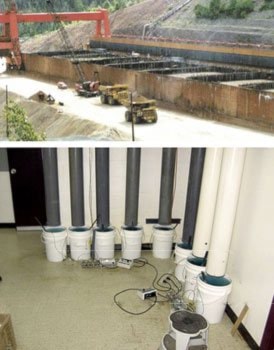A cleanup solution proposed for the Carmacks copper project may not work, according to a site-remediation expert.
This could saddle the Yukon public with toxic ore heaps for years to come.
“There will probably be significant environmental effects that will have to be dealt with in the long term,” said Gerry Couture of the Yukon Conservation Society.
“We’re quite certain that, if things are not done properly, this could be a perpetual-care situation.”
The project is currently under review by the Yukon Environmental and Socio-economic Assessment Board.
Western Copper Corporation has proposed an open-pit copper mine 38 kilometres northwest of Carmacks.
The proposed site is nine kilometres west of the Yukon River.
The corporation plans to extract 14,310 tonnes of copper a year using a process known as heap leaching.
In common parlance, the company will crush rock and stack it on a plastic liner.
An acid solution is then sprinkled on top of the crushed rock, percolating though like water through coffee.
The acid dissolves the copper.
The resulting copper-rich solution is collected. Electricity is applied to the toxic brew to create copper cathodes.
The process “leaches” about 80 per cent of the metal from the rock.
“It’s a really cheap and quick way of mining low-grade copper ore,” said Couture.
“The problem with it is that when you’re finished, you’re left with a relatively large heap — we’re talking in the millions of tonnes — of this acid-laced ore.”
That ore can continue to leak copper and other heavy metals into the ground and surface water for many years to come.
Western Copper proposes to clean up the site by rinsing the heaps of rock with water for four-and-a half years and then neutralize the acids with a dose of lime, which is a base.
It may not work, said Couture.
“Our research has indicated that there is no record of one of these heaps being successfully detoxified on an operational level anywhere.”
The conservation society commissioned a report by Lionel Catalan of Thunder Bay, Ontario’s, Lakehead University.
Catalan holds a Canada research chair in industrial waste management and site remediation.
“He’s probably the one person in the world who has done an operational scale project to see how this works,” said Couture.
“And his assessment is that what is being proposed by Carmacks Copper at this time does not have a very good prospect of achieving the kind of closure scenario they are talking about.”
Catalan conducted tests at a Quebec site using five massive vats, each containing approximately 4,000 tonnes of copper oxide ore. He used bulldozers to level the ore in his vats.
By comparison, Western Copper did its testing in a Vancouver lab using plastic buckets.
When rinsing and neutralizing the heaps, channels form, said Catalan. The solution flows through these channels more easily.
This creates areas that don’t get doused by the water and lime. They remain acidic even after repeated rinsing and could cause trouble later on.
“The closure plan aims to achieve a ‘walkaway’ scenario that will require no further monitoring and maintenance,” wrote Catalan in his report.
“When considering the technical information provided to sustain this claim, my opinion is that this claim is premature.”
“We can’t comment right now, because everything needs to go through the YESAB process,” said a Western Copper spokesperson.
“We are available for any clarification or further requests that YESAB might have.”
Today is the last day for the assessment board to receive public comments.
“If the heap is not detoxified and they walk away, the taxpayer gets left with cleaning it up — or it doesn’t get cleaned up and we have major environmental effects to the Yukon River,” said Couture.
“We’re not saying, don’t have this mine. We’re saying that the plan for having it now does not answer all the questions adequately.
“It has to be shown to be an adequate mining plan that will not leave us with an environmental problem later on — one that will have to be paid for by people that aren’t even born yet.”
